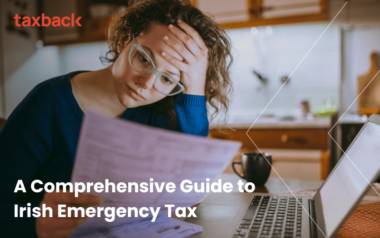Table of Contents Show
Why do people make charitable donations?
The single most common reason cited for making donations to charity is ‘tax deductions’.
This doesn’t mean you gain from giving the donation but rather you don’t pay tax on the money you gave away! Or it can mean that the tax you paid on such money is somewhat reduced, i.e. the actual cost of the donation received by the charity is reduced by your tax savings.
The general driver behind such reasoning is that someone is going to take a portion of your money, and that can either be the government or a charity of your choice (we all like to feel we have some control)!
While tax savings are a factor in many people’s decision to donate, we must acknowledge that people often just contribute to charity for reasons of religious/spiritual obligation, i.e. they wish to support the work of an organisation/church or they feel obliged to make donations by reason of their faith.
We take the hassle out of filing your Irish tax return
Surveys have proven that givers are happier than non-givers and in general we all like to feel we are making a contribution! In a time when we have so little control over many of our outgoings (taxes, mortgage payments, utility bills, etc.), charitable contributions are still something we can control, i.e. we decide when to give, how much to give, and who to give to!
Tax position – Ireland – pre 1 Jan 2013
For donations made by individuals the relief available differed between PAYE taxpayers (employees) and those required to submit annual tax returns (i.e. self-employed people, those with rental properties, investment income, company directors etc.).
PAYE Taxpayers
For PAYE taxpayers, the relief was allowed on a “grossed up” basis and was granted to the charity rather than to the individual making the donation. For example, if an individual who paid tax at the higher rate of 41% (or 40% from 2015) gave a donation of €250 to an approved charity, that charity was entitled to claim back the tax which had been applied to this income before it was received by the individual, i.e. the individual needed to earn €424 gross in order to have net income of €250 (ignoring PRSI and USC) to make such a contribution.
Tax at 41% was applied to the €424 (€174) via payroll and the charity was therefore entitled to claim this amount back from Revenue.
The net amount received by the charity differed depending on whether the individual was taxable at the standard (20%) or the higher (41% pre 2015 and 40% thereafter) rate.
The table below illustrates the net difference to the charity for an individual making a contribution of €250:
| Higher Rate Taxpayer | Standard Rate Taxpayer |
| Individual donates €250 take-home pay |
Individual donates €250 take-home pay |
| Charity applies to Revenue | Charity applies to Revenue |
| Charity receives additional €174 from Revenue |
Charity receives additional €62.50 from Revenue |
| Total amount received by Charity €424 |
Total amount received by Charity €312.50 |
The individual giving the donation in each of the above scenarios doesn’t receive any personal benefit from the donation but knows that when they make a contribution, the charity will receive a higher amount. In some cases, people may factor this into their decision in relation to the amount they contribute.
Self-Assessed Taxpayers
For these individuals, the relief was very different. There was no grossing up arrangement and instead they were entitled to claim relief on their annual tax return. The amount donated was deducted from the individual’s taxable income on their tax return thus reducing their tax bill, i.e. they were essentially not taxed on the income they no longer had.
In these circumstances, the amount received by the charity was not affected by the taxpayer’s tax rate.
The table below illustrates how the relief worked for such individuals:
| Higher Rate Taxpayer | Standard Rate Taxpayer |
| Individual donates €250 gross earnings |
Individual donates €250 gross earnings |
| Individual claims relief on tax return |
Individual claims relief on tax return |
| Individual’s liability is reduced by €102.50 |
Individual’s liability is reduced by €50 |
| Total amount received by Charity €250 |
Total amount received by Charity €250 |
We take the hassle out of filing your Irish tax return
Tax position in Ireland from 1 Jan 2013
With effect from 1 January 2013, the above changed and in fact the scheme for relief for charitable donations has been simplified considerably.
There is no longer any distinction between PAYE taxpayers and Self-Assessed taxpayers and the relief in respect of charitable donations will in all cases be refunded to the charity.
Relief will now be granted at the new blended rate of 31% rather than 20% or 41% (40% from 2015) as above. An annual limit of €1 million per individual that can be donated under the scheme is also being introduced.
Charities will be required to obtain certificates from their donors confirming their PPS numbers, the eligibility of the donation, and the fact that the tax they will pay for the year will be at least equal to the relief due to the charity.
As part of the simplification process, provision is being made for an enduring certificate which will last for up to five years and can be completed by a donor in lieu of an annual certificate.

Effect of changes for individuals
For PAYE taxpayers there will be little impact – such individuals never obtained any personal benefit (perceived or otherwise) from making a charitable donation.
For Self-Assessed taxpayers there is a difference. The tax relief is not lost but rather it is being granted in a different manner. As the relief for such taxpayers is now being granted on a grossed-up basis, some calculations may need to be done in order for taxpayers to be clear in advance of the making of a donation.
There is still a benefit for such people in making donations. Remember, no one ever really made a financial gain from a donation. The perceived gain arose via the fact that an individual did not pay the tax on the income that they donated, i.e. the income they no longer had.
Some examples:
| Old Regime | New Regime |
| Higher Rate Taxpayer | Higher Rate Taxpayer |
| Donates €500 | Donates €295 |
| Tax Liability reduced by €205 |
Tax Liability reduced by 0 |
| Net cost to taxpayer €295 |
Net cost to taxpayer €295 |
| Net donation received by Charity €500 |
Net donation received by Charity €427 |
Taking the above example, we’ve worked through the old and new regimes to illustrate how a taxpayer may calculate how much they should contribute. Clearly, in the above example, while the taxpayer’s net cost remains unchanged at €295, the charity has lost from old to new regime.
The following example illustrates the position for a standard rate taxpayer:
| Old Regime | New Regime |
| Standard Rate Taxpayer | Standard Rate Taxpayer |
| Donates €500 | Donates €400 |
| Tax Liability reduced by €100 |
Tax Liability reduced by 0 |
| Net cost to taxpayer €400 |
Net cost to taxpayer €400 |
| Net donation received by Charity €500 |
Net donation received by Charity €580 |
Taking the above example, it is clear that if the taxpayer is a standard rate taxpayer, the charity will gain under the new regime. If one were to assume that those making charitable donations were in equal measures standard rate and higher rate taxpayers, we would conclude that the net effect for charities will be neutral.
The following illustration may be helpful if the donor wishes to protect the net income of the charity:
| Old Regime | New Regime |
| Higher Rate Taxpayer | Higher Rate Taxpayer |
| Donates €500 | Donates €345 |
| Tax Liability reduced by €205 |
Tax Liability reduced by 0 |
| Net cost to taxpayer €295 |
Net cost to taxpayer €345 |
| Net donation received by Charity €500 |
Net donation received by Charity €500 |
Therefore, if a higher rate taxpayer wishes to ensure that his/her charity of choice receives a net payment of €500 it will cost them an additional €50 in 2013 as compared to 2012.
We take the hassle out of filing your Irish tax return
Effect of changes for charities
Will people be less inclined to make charitable donations further to the above changes?
Most likely not, as tax is not the only driver for people. Also, while it may appear to Self-Assessed taxpayers that there is no longer any benefit from making a donation, it’s clear from the above that there is still tax relief to be claimed. It just looks a little different. It is still possible to direct some of your hard earned cash to a charity rather than to the government!
Fill out the short form
Last Updated on March 6, 2024







